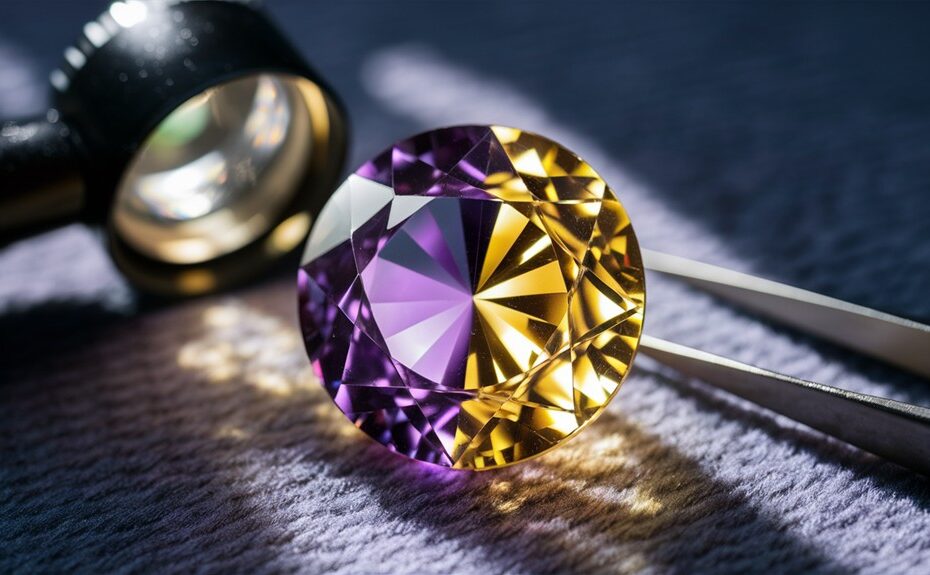When you're considering purchasing an ametrine gemstone, you'll want to be confident in its authenticity. This unique bi-colored quartz, with its striking blend of purple and yellow, can be a stunning addition to your collection—but only if it's genuine. As you delve into the world of ametrine, you'll uncover that several key factors can help you distinguish real stones from imitations. From color distribution to crystal structure, each element plays a vital role in authentication. By understanding these indicators, you'll be better equipped to make an informed decision and avoid costly mistakes. But what exactly should you look for?
Our Highlighted Points
- Genuine ametrine exhibits a balanced 50/50 split of purple and yellow hues with smooth color transitions.
- Authentic stones display natural asymmetry, minor inclusions, and subtle haziness, unlike overly perfect synthetic versions.
- Real ametrine typically weighs under 10 carats, with larger sizes potentially indicating synthetic origin.
- Legitimate sellers provide documentation confirming Bolivian origin, particularly from the Anahi Mine.
- Professional gemological evaluation using specialized equipment can definitively authenticate ametrine by examining c-axis positioning and color boundaries.
Understanding Ametrine's Unique Color Profile
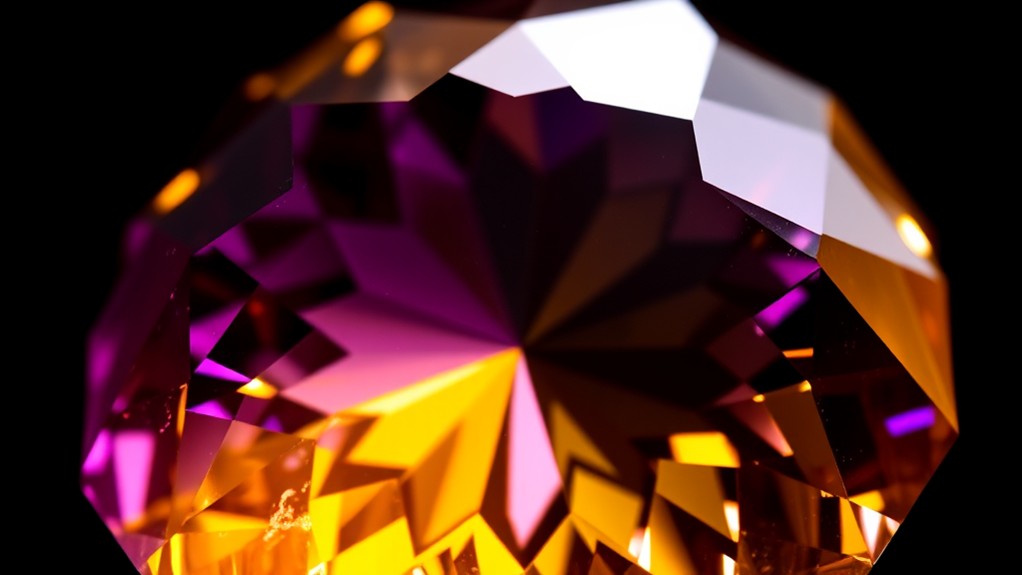
When you're examining ametrine, its unique color profile is the initial thing you'll notice. This bicolored quartz variety distinctively combines shades of purple and yellow within a single gemstone, representing both amethyst and citrine.
To identify genuine ametrine, observe the following characteristics:
- Color Distribution: Authentic ametrine typically exhibits a 50/50 split between purple and yellow hues.
- Color Blending: The two colors should smoothly transition rather than appear in distinct sections.
- Color Saturation: Natural quartz crystals tend to have paler color saturation compared to their synthetic counterparts.
- Color Purity: Genuine ametrine will only display purple and yellow hues; the presence of additional colors like blue or green indicates a fake.
- Color Boundary Alignment: In real ametrine, the color boundaries align closely with the crystal's c-axis, usually within 10 degrees.
To further authenticate your ametrine:
- Examine the stone under different lighting conditions to assess color consistency.
- Use a loupe or magnifying glass to inspect the color boundaries more closely.
- Compare the stone's appearance to known authentic specimens or high-quality reference images.
Examining Crystal Structure and Clarity
After assessing ametrine's color profile, you'll want to closely examine its crystal structure and clarity. Natural ametrine typically exhibits a slightly hazy appearance, which is a key indicator of authenticity. While genuine stones possess high clarity, they're not flawless. You'll often observe minor inclusions and imperfections, distinguishing them from their synthetic counterparts.
When examining ametrine's crystal structure and clarity, focus on these key aspects:
- Haziness: Look for a subtle, general haziness in the stone, indicating natural formation.
- Inclusions: Identify small imperfections or inclusions within the gem, which are characteristic of genuine ametrine.
- Color boundaries: Observe the alignment of purple and yellow color boundaries, which should be parallel to the c-axis within 10 degrees for natural stones.
Genuine ametrine's clarity is high but not perfect. You'll notice a balance between transparency and subtle imperfections. The purple color zones may appear slightly less saturated than in synthetic versions.
Assessing Size and Shape Authenticity
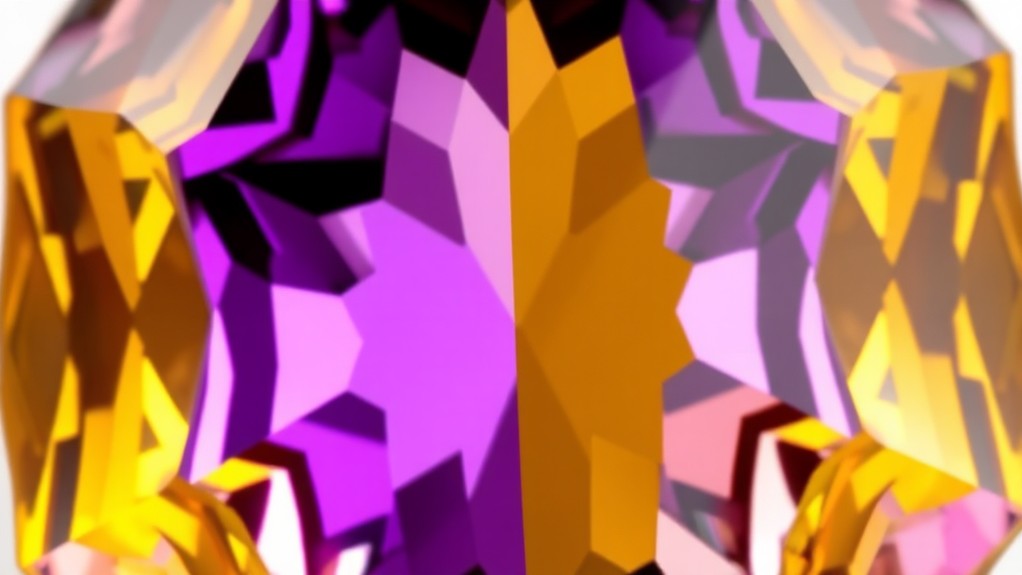
Size and shape play crucial roles in determining ametrine's authenticity. When assessing size and shape authenticity, keep in mind that genuine ametrine typically comes in sizes under 10 carats. Larger stones may indicate a synthetic origin, as naturally occurring ametrine of substantial size is rare.
To determine if ametrine is real, examine its shape closely:
- Look for natural asymmetry and imperfections in genuine stones.
- Be wary of overly uniform or symmetrical shapes, which often suggest artificial production.
Authentic ametrine is commonly found in oval, cushion, and round cuts. However, excessively geometric or precisely cut shapes should raise suspicion of fake ametrine.
As you assess the stone:
- Observe variations in thickness and color distribution across the gem.
- Check for a natural blend of colors with slight irregularities.
- Look for a noticeable transition between purple and yellow hues, often with a 50/50 split.
Identifying Natural Inclusions and Flaws
Natural inclusions and flaws are telltale signs of genuine ametrine. When examining a stone to determine its authenticity, you'll want to look closely for these characteristics that distinguish real ametrine from synthetic versions.
Authentic ametrine typically contains minor imperfections and inclusions that contribute to its unique beauty and verify its natural origin.
To identify natural inclusions and flaws in ametrine:
- Inspect for haziness or opacity: Genuine ametrine often exhibits some level of cloudiness, while synthetic stones tend to appear glassy and overly clear.
- Look for color zoning: Authentic ametrine will show distinct separation between purple and yellow hues, a feature often absent in synthetic stones.
- Search for bubble-like inclusions: Small, irregular features within the stone indicate natural formation processes.
When assessing an ametrine's authenticity, pay attention to asymmetrical color distribution and natural imperfections.
Synthetic stones usually lack these characteristics, appearing too perfect or uniform. By carefully examining these aspects, you can distinguish between genuine ametrine and its synthetic counterparts.
Verifying Geographic Origin Claims
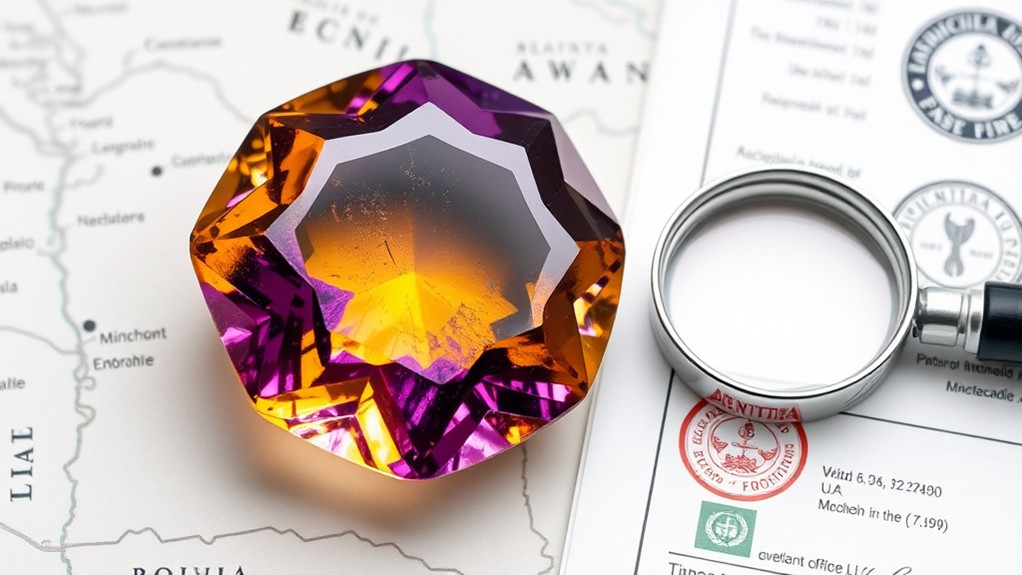
Verifying the geographic origin of ametrine is vital in determining its authenticity. The Anahi Mine in Bolivia is the sole source of genuine ametrine, making it critical to scrutinize claims of different origins.
When purchasing ametrine, consider the following:
- Request provenance documentation: Legitimate sellers should provide paperwork confirming the stone's Bolivian origin.
- Examine the color split: Authentic ametrine typically exhibits a 50/50 distribution between purple and yellow hues.
- Be skeptical of alternative sources: Claims of ametrine from locations other than Bolivia should raise red flags.
- Consider the mine's accessibility: The Anahi Mine's remote location, accessible only by boat or challenging roads, adds credibility to genuine stones.
To guarantee you're acquiring authentic ametrine:
- Ask detailed questions about the stone's origin
- Research the seller's reputation and expertise
- Compare the gem's characteristics to known Bolivian ametrine standards
- Seek a professional gemologist's opinion if uncertain
Analyzing Price Point Indicators
Three key price point indicators can help you determine if an ametrine is real. When assessing the authenticity of this purple-yellow gem, it's essential to take into account the price in relation to its quality and origin. Understanding these indicators will assist you in making an informed purchase and avoiding synthetic gemstones or low-quality imitations.
- Price per carat: Authentic ametrine typically costs between $5 and $30 per carat, with exceptional stones fetching up to $800 or more.
- Quality vs. price correlation: Eye-clean stones with deep saturation command higher prices because of their rarity and desirability among collectors.
- Documentation and origin verification: Genuine ametrine from the Anahi mine in Bolivia may come with certification, increasing its value.
Be cautious of ametrine priced considerably below $5 per carat, as this may indicate low quality or synthetic origins.
Reputable sellers should disclose if the stone is synthetic, which is typically created through heat treatment or hydrothermal methods and priced much lower than natural ametrine.
Conducting Basic At-Home Tests
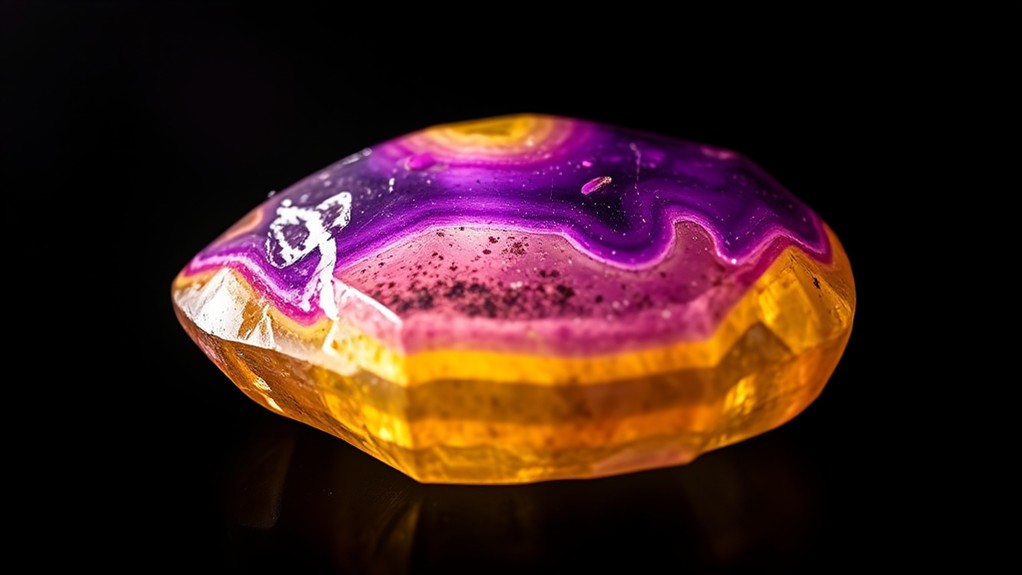
You don't need expensive equipment or professional expertise to conduct some basic tests on your ametrine at home. To check for authenticity, start by examining the color zoning of your ametrine gemstone. Look for a natural blend of purple and yellow without excessive vibrancy or extra hues. Then, you can also perform a visual inspection for any signs of color enhancement, such as an unnatural uniformity of color throughout the gemstone. Finally, you can consider using pearl authentication methods to further ensure the authenticity of your ametrine, such as conducting a specific gravity test or using a UV light to check for fluorescence. These simple tests can give you a good indication of whether your ametrine is a genuine and natural gemstone.
Next, perform a scratch test using a material with a hardness lower than 7 on the Mohs scale. Genuine ametrine shouldn't scratch easily because of its durability.
Inspect the stone for natural flaws and minor inclusions. Authentic ametrine typically exhibits some imperfections, while synthetic versions often appear too perfect.
Moreover, check for a slightly hazy or opaque appearance, which can indicate authenticity. Natural ametrine often has these characteristics, whereas synthetic alternatives tend to be crystal clear.
For a more advanced test, use a polariscope to observe the color boundaries. In genuine ametrine, these boundaries should be parallel to the c-axis within 10 degrees. Synthetic stones often have boundaries off by 20-38 degrees.
Recognizing Synthetic Ametrine Characteristics
Recognizing synthetic ametrine requires a keen eye for detail and an understanding of its telltale characteristics.
When examining a purple and yellow gemstone, you'll need to know the key differences between real ametrine and its fake counterparts. Synthetic versions often display overly vivid colors or additional hues like blue or green, which are absent in genuine stones.
Real ametrine typically exhibits natural asymmetry and minor imperfections, while synthetic stones may appear too perfect and uniform.
To distinguish between authentic and synthetic ametrine, consider these essential factors:
- Color zoning: Genuine ametrine features subtle, balanced color distribution, usually in a 50/50 split between purple and yellow.
- Weight and feel: Real ametrine has a substantial feel, unlike synthetic imitations that may seem plastic-like or too lightweight.
- Batch uniformity: A large number of identical stones in a group often indicates synthetic origin, as natural ametrine stones possess unique characteristics.
Seeking Professional Gemological Evaluation
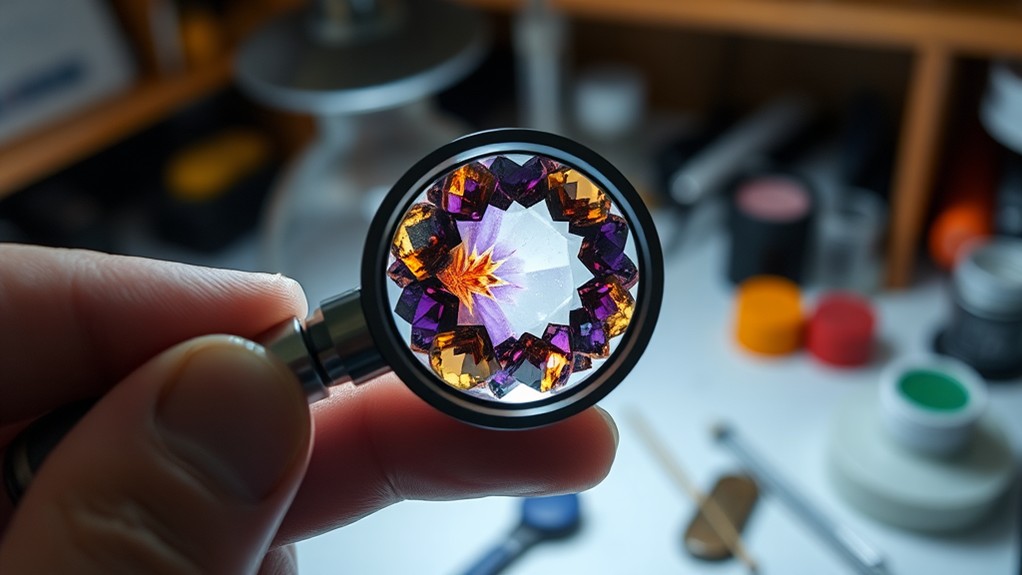
While visual inspection can provide clues, the ultimate way to verify ametrine's authenticity is through professional gemological evaluation. Experts possess specialized equipment and knowledge to detect features invisible to the naked eye, making their assessment vital for confirming whether a specimen is genuine or synthetic quartz sold as natural ametrine.
Key benefits of seeking professional evaluation:
- Accurate authentication: Gemologists can identify significant c-axis positioning and examine color boundaries to differentiate between natural and synthetic ametrine.
- Extensive quality assessment: Professionals evaluate factors such as clarity, color distribution, and overall quality of the amethyst and citrine zones.
- Market value insights: Expert appraisals provide information on the gemstone's worth, which is valuable for potential resale or insurance purposes.
- Detection of treatments: Professionals can identify any improvements or treatments applied to the stone.
Professional gemological evaluations typically cost between $50 to $150 per hour, offering a detailed assessment of your ametrine. While this may seem costly, it's a small price to pay for peace of mind and protection against purchasing fraudulent stones.
Frequently Asked Questions
How to Tell if Ametrine Is Real?
You can determine if ametrine's real by checking its color blend, flaws, and clarity. Look for a natural purple-yellow split without other hues. Genuine stones have slight imperfections and pale colors. Verify it's from Bolivia's Anahi mine.
What Is the Difference Between Natural and Synthetic Ametrine?
You'll notice natural ametrine has softer colors and minor flaws, while synthetic versions appear more perfect with vivid hues. Natural stones come exclusively from Bolivia, but lab-created ones can be made anywhere using artificial methods.
Why Is Ametrine so Expensive?
You'll find ametrine's high price stems from its rarity. It's mined in limited locations, mainly Bolivia's Anahi mine. The gem's unique bicolor and quality drive demand, while scarcity and mining costs further increase its value.
Is It Worth It to Buy Ametrine?
If you're looking for an affordable, unique gemstone, ametrine's worth considering. You'll get a beautiful purple-yellow blend that's rare and meaningful. It's great value for money, appealing to both casual buyers and serious collectors.
